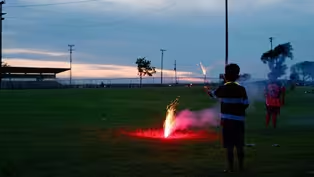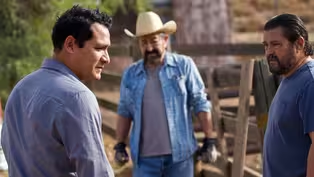
Sabor Ártico: Latinos En Alaska
Special | 14m 10sVideo has Closed Captions
This short documentary shows Latinos adapting to the Arctic via food and culture.
Latinos face unique challenges in the Arctic environment where things can be extreme, remote, and sometimes inaccessible. “Sabor Ártico: Latinos En Alaska,” a short documentary, introduces viewers to a growing population of Latinos in Alaska through poignant interviews that give insight on the importance of food and culture in adapting to the Arctic environment and in forging their identity.
Problems playing video? | Closed Captioning Feedback
Problems playing video? | Closed Captioning Feedback

Sabor Ártico: Latinos En Alaska
Special | 14m 10sVideo has Closed Captions
Latinos face unique challenges in the Arctic environment where things can be extreme, remote, and sometimes inaccessible. “Sabor Ártico: Latinos En Alaska,” a short documentary, introduces viewers to a growing population of Latinos in Alaska through poignant interviews that give insight on the importance of food and culture in adapting to the Arctic environment and in forging their identity.
Problems playing video? | Closed Captioning Feedback
How to Watch VOCES
VOCES is available to stream on pbs.org and the free PBS App, available on iPhone, Apple TV, Android TV, Android smartphones, Amazon Fire TV, Amazon Fire Tablet, Roku, Samsung Smart TV, and Vizio.
Buy Now
Providing Support for PBS.org
Learn Moreabout PBS online sponsorshipMore from This Collection
Video has Closed Captions
A filmmaker documents the effects of the oil industry in her hometown. (9m 57s)
Video has Closed Captions
A poetic story of self-discovery through West African and Afro-Mexican art practices. (17m 22s)
Video has Closed Captions
A young Latinx reporter investigates a COVID outbreak in his hometown meatpacking plant. (26m 54s)
Providing Support for PBS.org
Learn Moreabout PBS online sponsorship[Music] Yes, there are Latinos in Alaska.
And their story is unique.
They bring their best, their cultures and their food.
And when they arrive, they find that in Alaska, everything is different.
You always dance around the kitchen, always dancing.
In the kitchen.
When youre cookin up that love I cried helpless.
I'm helpless.
I'm so helpless in love.
Alaska is the great land.
One fifth the size of the continental United States.
It is the most western, eastern, northern and the only Arctic state in the U.S.
Yet only about 733,000 people live in the great land.
The population of Latinos in Alaska has grown by leaps and bounds.
More than 35% over the last two decades alone.
The Latino community comprises new immigrants, as well as immigrant families that have called Alaska home for generations.
I actually didn't know I was Mexican until I was like eight years old, and I moved in with my dad.
For some hard reasons my mom couldn't take care of me and she just dropped me off with my dad.
And one day as I was living with him, I was like, you know, I'm Alaska native, but who are you?
Like, Where are you from?
And he was like And I was like, What does that mean?
You know?
And then he just started telling me, like, our family tree and telling me like, how he grew up.
One of the biggest challenge for the Latino families is how do you help your children to flourish in, in this new land without losing their knowledge of your roots?
For many young Latinos in Alaska, especially those who have never left the state, their identity is shaped by the food and culture that their families bring.
If culture is a response to the environment and food is a reflection of the land, then Latinos in Alaska have an identity all their own.
My sister dipnets which is a style of fishing in Alaska.
I've been dipnetting for about 20 years.
It's like home away from home.
The water, the waves.
It's a part of me.
Only Alaskan residents can dipnet for personal use.
Since 2003, Alaskans harvest between 130,000 and 540,000 sockeye salmon annually in this fishery.
My family enjoys eating salmon, and so it's to take care of my family.
Traditionally, I like to continue to do it, you know, with a little bit of Mexican cuisine.
I mean, I can bake it.
I can deep fry it, you know, coconut salmon, salmon quesadillas, a nice seafood soup with fresh salmon in there, salmon tacos.
When you're talking about 65 salmon per household, that's a lot of fish.
She has given birth to a tradition.
In our family.
Although summer fishing and harvesting provide sustainable resources for Alaskans, it is not sufficient to sustain Alaskans through the year.
The state still imports more than 90% of its food.
That translates to almost $2 billion a year in food that must be shipped to Alaska.
We're in Alaska, so we're not always going to be the first ones to receive the fresh produce, especially in the middle of winter.
I wouldnt want to make tamales here.
We've made them in California and people are like, make them here.
But, you know, you have everything there.
You're so close to Mexico, but here it's a little challenging.
-- That I wouldnt attempt it.
-- Yeah.
Food production and harvesting across the Americas was successful well before colonization.
Ancestral foods from Latin America are found at tables across the world.
They are products like potatoes, squash, corn and chocolate, to name a few.
As I got more connected to my native culture and learning about like indigenous food systems before colonization, I started realizing how important it is to go to foods that are not just vegetarian, but just not so processed.
Alaska is not an easy place to live.
And so to choose to be a part of this community means that you're going to need to invest part of yourself.
It takes work, and if you're going to put that work in, you need to make sure that that work is true to yourself.
So coming as you are bringing your traditions, your customs, your languages, your food, your your traditions, your history, all of that needs to be a part of surviving and living and thriving here in Anchorage.
Immigrant Latinos in Alaska form part of a larger immigrant community that helps drive the Alaskan economy.
And what's so exciting is to see when children come with their parents to our restaurant, they eat all of this food She's the one that prepares everything from her heart.
She makes everything from her hand, all from scratch.
All the way down to the tortilla.
Latinos find that their shared historical experiences with the first peoples of Alaska can help build a foundation for a home in the Arctic.
I think about how the similar values of like family, kinship, respect, respect of your elders meant leaving places better than you found them.
That that's a value shared across cultures and especially at the table.
Latino culture is defined by ancestral ties to food one cultural practice that has grown in Anchorage as the community has grown is Día de Muertos, a holiday that honors ancestors through the offering of food.
I had the opportunity to be a part of Día de Muertos the first year that I came up to Anchorage.
And it was a little bit of a surprise to to find how many folks got involved here in the community and made it possible not just within the Latino community, but in the Anchorage community overall.
We're in a really exciting time where kids are allowed to be excited about their culture especially here in Alaska, where connection to culture is so important and play such a significant role in the creation of community.
Food and culture are inseparable Latinos and Alaska are symbiotic.
Latino food and culture is changing Alaska and Alaska is changing.
Latino food and culture.
Sabor Ártico: Latinos En Alaska Extended Trailer
Video has Closed Captions
Preview: Special | 1m | This short documentary shows Latinos adapting to the Arctic via food and culture. (1m)
Providing Support for PBS.org
Learn Moreabout PBS online sponsorshipSupport for PBS provided by:



















